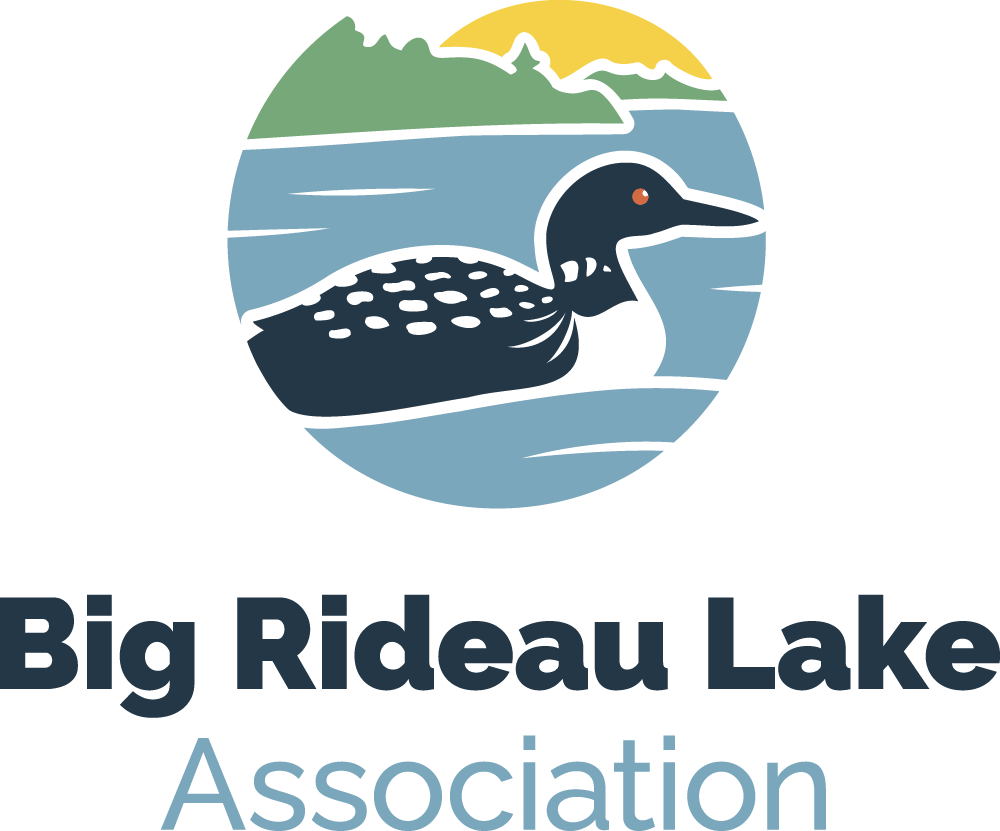
Double crested Cormorant colony on Big Rideau Lake
The Board of Directors approved in June 2015 the undertaking of a study of the double crested cormorants on north Owl Island [also known as north Brother Island]. The islands are owned and managed by the Government of Ontario and OMNRF.
Through Driftwords, the general membership was asked at that time if they had any thoughts about cormorants on the lake but very little response was heard.
The 2015 cormorant study ran from June until November and consisted of a preliminary vegetation survey and monthly photographic record being established for the island. Several counts of cormorants were made through the summer nesting period resulting in the highest count of 63 resident birds along with 8 active nests. Allowing for birds that may have been away from the colony at the time of the counts, it is probably realistic to increase the maximum number to something closer to 100 as being the resident population. A BRLA file record was found for a 2010 population estimate of 50 plus cormorants on the island and similarly that count should be increased for birds away. On balance, what this data clearly shows is that the resident colony of cormorants is holding very stable in numbers and not increasing.
Starting in early September each year numerous other cormorants arrive and roost on nearby rocky shoals and in rafts in various other parts of the lake. In 2015, they numbered between 500 and 1000 birds and were identified as transients from some distant colonies and were no doubt on their regular southward fall migration.
Our ongoing search for other information on double crested cormorants has turned up more useful and interesting information to be considered. A concern had been expressed locally about the amount of guano and related residue that is entering the lake from the double crested cormorant colony and the fall migrants. Rideau Valley Conservation Authority’s (RVCA) multi-year research on phosphorus levels in multiple locations in Big Rideau Lake indicate that these concerns about water pollution from the colony are not appearing to be validated. While phosphorous is a potent fertilizer of aquatic plants and a significant constituent of guano, the RVCA found the lowest levels of phosphorus [which is good] not far from the cormorant colony and highest levels [which is not so good] in the Lower Rideau.
Another scientific report of note, published in 2015, for another Ontario lake, directly linked through the food chain the suppression of blue green algae concentrations by top level predators such as cormorants and many other birds and larger fish. Such a mechanism has been theorized in 1992 and 2015 in the Township's Capacity Study which delves into the ecology of Big Rideau Lake. Now it has been proven as a natural mechanism in a lake elsewhere in Ontario. Any natural process which reduces blue green algae populations and threats for our lake can only be viewed as a better situation to be in.
The Board of Directors of the BRLA has closely followed local debates on cormorants and concerns about how they might be managed on Big Rideau Lake. Various reports and Letter to the Editor comments in the local press have attributed views and actions to the BRLA Board which are both spurious and factually wrong. The Board encourages BRLA members to communicate directly with the President, Brian Hawkins, to clarify any item that may concern them.
As part of the local and provincial debate on cormorant populations, the President and the Chair of the Environment Committee made a joint presentation to The Township of Rideau Lakes on March 14 where they re-iterated the BRLA Board’s position on cormorants established in June 2015. That position is to maintain protections already established in Ontario law for double crested cormorants on public lands and for private property owners to allow time for scientifically based facts to be gathered on our Big Rideau Lake colony. Further,any BRLA positions developed on management needs for cormorants on our lake should be based on as full a consideration as possible for the ecological dynamics at work in the lake and on the island.
This position does not leave property owners without recourse to cormorant incursions onto their property. The existing legal protections for cormorants in Ontario provide ample opportunity for property owners to protect their private property through culls and harassment of cormorants that might come there. Upon request, BRLA can provide any member who wishes clarification on the existing laws and related OMRNF policy.
WANTED: Your views and Your help
* The Chair of the Environment Committee and the Board of Directors welcomes input from the general membership on their views about the double crested cormorant colony currently existing on Big Rideau Lake and our activities in better defining what their role is in the ecology of the lake and island and the food chain and any needed future management. Email may be sent to environment@bigrideaulakeassociation.com.
* The BRLA will continue the study of the double crested cormorant colony in 2016 and following years. You can be part of that effort. Cormorant counts at the colony and on the lake will be done about every two weeks from May through November. You [and your family] can participate in your boat using the study format provided to you by BRLA. Do one days’ survey or several…whatever works for you. Its educational and its easy! Great for the kids!... and to get to better understand the natural history of Big Rideau Lake. For further information on how you can participate please email the project coordinator at environment@bigrideaulakeassociation.com.



